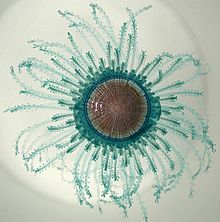| Porpita porpita | |
|---|---|

| |
| Blue button | |
| Scientific classification | |
| Domain: | Eukaryota |
| Kingdom: | Animalia |
| Phylum: | Cnidaria |
| Class: | Hydrozoa |
| Order: | Anthoathecata |
| Family: | Porpitidae |
| Genus: | Porpita |
| Species: | P. porpita
|
| Binomial name | |
| Porpita porpita | |
Porpita porpita, or the blue button, is a marine organism consisting of a colony of hydroids[2] found in the warmer, tropical and sub-tropical waters of the Pacific,[3] Atlantic, and Indian oceans, as well as the Mediterranean Sea and eastern Arabian Sea.[4] It was first identified by Carl Linnaeus in 1758, under the basionym Medusa porpita.[5][6] In addition, it is one of the two genera under the suborder Chondrophora, which is a group of cnidarians that also includes Velella.[7] The chondrophores are similar to the better-known siphonophores, which includes the Portuguese man o' war, or Physalia physalis. Although it is superficially similar to a jellyfish, each apparent individual is actually a colony of hydrozoan polyps. The taxonomic class, Hydrozoa, falls under the phylum Cnidaria, which includes anemones, corals, and jellyfish, which explains their similar appearances.
- ^ Schuchert P, ed. (2011). "Porpita porpita (Linnaeus, 1758)". World Hydrozoa database. World Register of Marine Species. doi:10.14284/170. Retrieved 2011-12-18 – via VLIZ.
- ^ Meinkoch, Norman (1981). The Audubon Field Guide to North American Seashore Creatures. The Audubon Field Guides. New York, NY: Audubon Society.
- ^ Gul, Shahnawaz; Gravili, Cinzia (11 March 2014). "On the occurrence of Porpita porpita (Cnidaria: Hydrozoa) at Pakistan coast (north Arabian Sea)". Marine Biodiversity Records. 7 (online ed.): e24. doi:10.1017/S1755267214000189. ISSN 1755-2672.
- ^ Lillo, Antonio; Tiralongo, Francesco; Tondo, Elena (2019). "New records of Porpita porpita (Linnaeus, 1758) (Cnidaria: Hydrozoa) in the Mediterranean Sea". Natural and Engineering Sciences. 4: 293–298. doi:10.28978/nesciences.646425.
- ^ Calder, Dale R. (August 2010). "Some anthoathecate hydroids and limnopolyps (Cnidaria, Hydrozoa) from the Hawaiian archipelago". Zootaxa. 2590 (1): 31. doi:10.11646/zootaxa.2590.1.1.
- ^ Deidun, Alan (2010). "Notes on the recent occurrence of uncommon pelagic 'jellyfish' species in Maltese coastal waters". Naturalisa Siciliano. 3-4. 4 (34): 375–384.